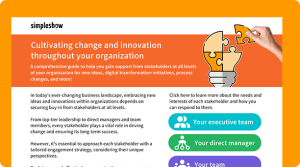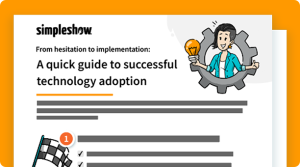Incorporating explainer videos at every level of the innovation process
Innovation thrives on effective communication and engagement. It’s a dynamic process that can bring transformative change. Enter explainer videos – a game-changer in how we communicate and comprehend innovative ideas. When you combine great innovation with impactful explainer videos, you have the power to revolutionize every phase of the innovation process.
Use this guide as inspiration for effectively incorporating explainer videos during each phase of the innovation process.
1. Getting stakeholder buy-in

Getting team members at all levels of your organization on board from the beginning is key. Their feedback will give you valuable insights as you continue to push forward with integrating a new innovative idea. (Need help identifying how to communicate with different stakeholders? Check out our quick guide: Cultivating change and innovation throughout your organization.)
How?

Use explainer videos to introduce the new idea. These short, digestible videos will help you convey your message clearly so anyone can understand. Be sure to identify your audience for each video, and highlight the aspects of the innovation that carry the most weight for that specific group.
Storytelling is not just for kids. Use business storytelling to engage viewers emotionally and help them connect with the innovation on a deeper level. Frame the video around a relatable narrative that presents a problem or challenge, introduces the idea as a solution, and shows your viewers how it can positively change the situation.
Pro tip


2. Prototyping and validation

Pilot testing allows the innovation to be tested on a small scale. It helps assess its feasibility, identify potential problems or challenges, gather user feedback, and make necessary adjustments. Pilot testing reduces risk, improves the effectiveness of the innovation, and increases the chances of successful implementation on a larger scale.
How?

Use explainer videos to provide clear directions during pilot testing, and to explain features and benefits in a simple way. This will help viewers better understand the tool or new process and provide useful feedback that will help you in the implementation phase.
Your viewers don’t need all of the details about your innovation, they just need to know the key features and benefits. Keep your videos concise and under 3 minutes. By keeping the explainer video short and sweet, you can capture and maintain the attention of viewers, making it easier for them to grasp the essential aspects of the innovation and provide valuable feedback without feeling overwhelmed.
Pro tip


Did you know?
simpleshow video maker is designed to help users simplify complex topics. Templates and guidelines will help you create a video that is easy to understand. Want to know the keys to simplification? Check out this guide on simplification for tips and tricks on making your communications clear and concise!
3. Product launch and communication plan

Setting up a timeline for important activities like pilot testing, training sessions, and full-scale implementation is crucial. By clearly communicating these milestones, teams can synchronize their efforts, monitor progress, and ensure everyone is on the same page regarding the implementation timeline.
How?

Create a series of explainer videos that cover each milestone of the implementation phase. By customizing these explainer videos, you can tailor the content to specific departments, ensuring that the information is relevant and relatable to each team. For example, if your innovation impacts the sales department, create an explainer video that highlights the specific benefits and features that sales teams can use to improve their performance and achieve their goals.
Include a strong call-to-action (CTA). End the video with a clear and compelling call-to-action that encourages viewers to take the next step. Make the CTA prominent and easy to follow.
Pro tip


4. Training and support

Proper training enables a smooth transition, reduces resistance to change, and maximizes the benefits of the tool or process. Ongoing support ensures that employees have assistance, troubleshooting support, and guidance as they integrate the new tool or process into their workflows, promoting successful adoption and long-term sustainability.
How?

Make training videos easily accessible. Consider hosting them on a centralized platform, such as an internal learning management system (LMS) or intranet portal. This ensures that employees can easily access the videos at any time and from anywhere within the organization’s network. By providing a dedicated and easy-to-navigate training platform, employees can conveniently view explainer videos, refer back to them as needed, and access additional training resources.
Microlearning is a powerful approach that allows for the effective delivery of information in bite-sized units. By breaking down complex topics into smaller, manageable units, you can ensure that your employees are not overwhelmed with an excessive amount of information all at once. The key is to create learning nuggets that are concise and focused, with explainer videos that are no more than two and a half minutes long. This way, you can capture and maintain your audience’s attention, making the learning experience more engaging and impactful
Pro tip


Did you know?
The simpleshow Story Generator makes creating videos fast and easy with automated script writing. Create scripts for a series of training videos without any of the hard work. Learn more about how content creation is now automated.


